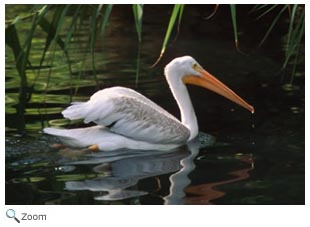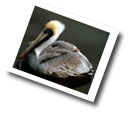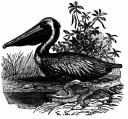 There are eight species of large water birds in this family. Pelicans are found on lakes and in coastal regions around the world. They live and travel in groups. There are eight species of large water birds in this family. Pelicans are found on lakes and in coastal regions around the world. They live and travel in groups.
Pelicans are easily identified by their long bills and gular pouches. A pelican uses its bill and pouch like a net. It dives into the water, scoops up fish and water, strains out the water from the sides of its bill, tips back its head and swallows the fish it caught. A pelican doesn't carry fish in its pouch, it only use its pouch to scoop up fish!
 Pelecanidae Photo Gallery Pelecanidae Photo Gallery
World Status Key
 Least Concern Least Concern  Near Threatened Near Threatened  Vulnerable Vulnerable  Endangered Endangered  Critically Endangered Critically Endangered  Extinct in Wild Extinct in Wild  Extinct Extinct
Status and range is taken from ICUN Redlist. If no status is listed, there is not enough data to establish status.
US Status Key
 Threatened in US Threatened in US  Threatened in NH Threatened in NH  Endangered in US Endangered in US  Endangered in NH Endangered in NH  Breeds in NH Breeds in NH  Introduced Introduced
Status taken from US Fish and Wildlife and NH Fish and Game
Additional Information
Key:  Profile Profile  Photos Photos  Video Video  Audio Audio
Pelicans  
Pelicans are an old family of birds, with fossils dating back almost 40 million years.
Source: San Diego Zoo Intended Audience: General Reading Level: Elementary/ Middle School Teacher Section: Yes
American White Pelican - Pelecanus erythrorhynchos     
The American white pelican breeds in isolated areas from Manitoba, Canada and Minnesota west to northern California. It winters in California, Mexico, Central America, along the Gulf Coast, and in Florida.
Source: Arkive Intended Audience: General Reading Level: Middle School Teacher Section: Yes
American White Pelican - Pelecanus erythrorhynchos    
American white pelicans winter in coastal bays and estuaries.
Source: Animal Diversity Web Intended Audience: General Reading Level: Middle School Teacher Section: Yes
American White Pelican - Pelecanus erythrorhynchos     
The American white pelican does not dive for fish, it dips its head underwater to scoop up fish.
Source: Cornell Lab of Ornithology Intended Audience: General Reading Level: Middle School Teacher Section: No
American White Pelican - Pelecanus erythrorhynchos    
American white pelicans nest on islands in colonies that can include several hundred pairs.
Source: Internet Bird Collection Intended Audience: General Reading Level: Middle School Teacher Section: No
Australian Pelican - Pelecanus conspicillatus     
The Australian pelican is found in Australia, Indonesia, Papua New Guinea, the Solomon Islands, and Timor-Leste.
Source: Animal Diversity Web Intended Audience: General Reading Level: Middle School Teacher Section: Yes
Australian Pelican - Pelecanus conspicillatus     
The Australian pelican has the longest bill of any bird species.
Source: Internet Bird Collection Intended Audience: General Reading Level: Middle School Teacher Section: No
Brown Pelican - Pelecanus occidentalis    
The brown pelican breeds along the Pacific coast from California to Chile and along the Atlantic coast from South Carolina through the Caribbean to Venezuela
Source: Arkive Intended Audience: General Reading Level: Middle School Teacher Section: Yes
Brown Pelican - Pelecanus occidentalis    
The brown pelican is a coastal bird. It is rarely seen inland.
Source: Animal Diversity Web Intended Audience: General Reading Level: Middle School Teacher Section: Yes
Brown Pelican - Pelecanus occidentalis      
The brown pelican is the only pelican species that plunges from the air into the water to catch its food.
Source: Cornell Lab of Ornithology Intended Audience: General Reading Level: Middle School Teacher Section: No
Brown Pelican - Pelecanus occidentalis      
The brown pelican is a dark brown bird with a white to pale yellow neck and black feet and legs.
Source: National Zoo Intended Audience: General Reading Level: Middle School Teacher Section: Yes
Brown Pelican - Pelecanus occidentalis     
The brown pelican nests on the ground.
Source: Philadelphia Zoo Intended Audience: Students Reading Level: Middle School Teacher Section: Yes
Brown Pelican - Pelecanus occidentalis     
The brown pelican eats shrimp and small fish like anchovies, sardines, and menhaden.
Source: Los Angeles Zoo Intended Audience: Students Reading Level: Elementary/Middle School Teacher Section: Yes
Brown Pelican - Pelecanus occidentalis     
The brown pelican is the sate bird of Louisiana.
Source: Internet Bird Collection Intended Audience: Students Reading Level: Elementary/Middle School Teacher Section: No
Dalmatian Pelican - Pelecanus crispus       
The Dalmatian pelican breeds from southeastern Europe to India and China
Source: Arkive Intended Audience: General Reading Level: Middle School Teacher Section: Yes
Dalmatian Pelican - Pelecanus crispus      
The Dalmatian pelican is the largest pelican species. It is 67-75 inches in length and has a wingspan of close to 10 feet.
Source: Internet Bird Collection Intended Audience: General Reading Level: Middle School Teacher Section: No
Great White Pelican - Pelecanus onocrotalus       
The great white pelican is found from southeastern Europe through Asia and Africa.
Source: Arkive Intended Audience: General Reading Level: Middle School Teacher Section: Yes
Great White Pelican - Pelecanus onocrotalus      
The great white pelican is found in freshwater lakes, deltas, marshes, and swamps.
Source: Animal Diversity Web Intended Audience: General Reading Level: Middle School Teacher Section: Yes
Great White Pelican - Pelecanus onocrotalus       
The great white pelican is all white with a pink face and pink legs.
Source: Internet Bird Collection Intended Audience: General Reading Level: Middle School Teacher Section: No
Peruvian Pelican - Pelecanus thagus    
The Peruvian pelican is found in Peru and Chile.
Source: Arkive Intended Audience: General Reading Level: Middle School Teacher Section: Yes
Pink-backed Pelican - Pelecanus rufescens     
The pink-backed pelican is one of the smallest of the eight pelican species.
Source: Bristol Zoo Intended Audience: General Reading Level: Middle School Teacher Section: Yes
Pink-backed Pelican - Pelecanus rufescens     
The pink-backed pelican is gray and white, with a pinkish back
Source: Internet Bird Collection Intended Audience: General Reading Level: Middle School Teacher Section: No
Spot-billed Pelican - Pelecanus philippensis     
The spot-billed pelican is found in Cambodia, India, Indonesia, Laos, Myanmar, Nepal, Sri Lanka, Thailand, and Vietnam.
Source: Arkive Intended Audience: General Reading Level: Middle School Teacher Section: Yes
Spot-billed Pelican - Pelecanus philippensis     
The spot-billed pelican is a social bird, and it lives and travels in flocks.
Source: Animal Diversity Web Intended Audience: General Reading Level: Middle School Teacher Section: Yes
Spot-billed Pelican - Pelecanus philippensis     
The spot-billed pelican is white and has a gray crest on its head and a brown tail
Source: Internet Bird Collection Intended Audience: General Reading Level: Middle School Teacher Section: No |
 There are eight species of large water birds in this family. Pelicans are found on lakes and in coastal regions around the world. They live and travel in groups.
There are eight species of large water birds in this family. Pelicans are found on lakes and in coastal regions around the world. They live and travel in groups. 

